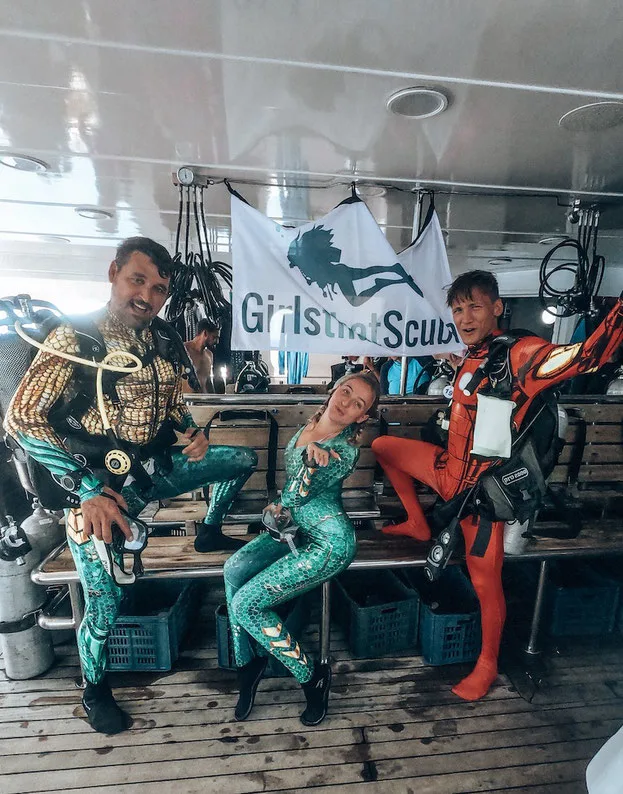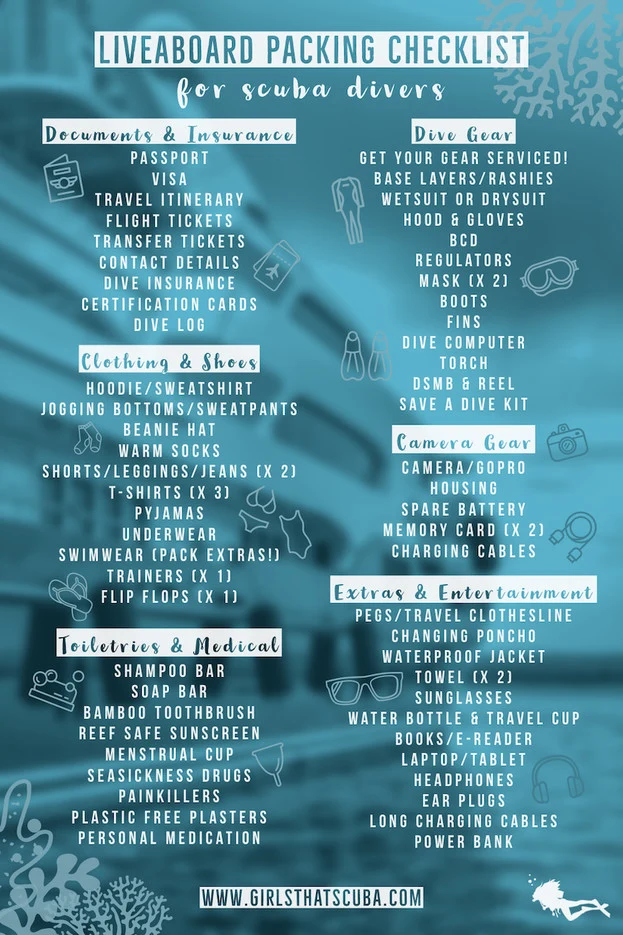You’ve finally booked that dream scuba adventure, and now you’re left wondering what should I pack for a liveaboard dive? We’re here to run through the liveaboard essentials with our full scuba diving packing list.
From dive equipment to what clothing to pack – as well as what to leave behind – this is your ultimate liveaboard diving packing list. We’ve also included a handy liveaboard packing checklist at the end of this post which you can save to tick off as you pack!
Looking at booking a liveaboard trip?
Take a look at over 280 all over the world here
Documents & Insurance
Documents
You won’t get far without your travel documents, so these should come top of your liveaboard diving packing list. Ensure that you have your passport, visa (if required), flight tickets, travel itineraries, tickets for any transfer arrangements, and contact numbers for any operators you’re using along the way.
Whilst most of these can be presented as digital tickets on your smartphone nowadays, it’s worth carrying physical back-ups in case of technical difficulties.
Local Currency
Although liveaboards are mostly all inclusive, you’ll still want to transfer some local currency ahead of your trip. This will be needed for your land-based days before embarking and after you return, as well as for tipping your hard working crew.
Travel and Dive Insurance
Ensure you have travel insurance and dive insurance arranged ahead of your trip, and remember to carry the details of these policies. DAN is relied on by divers worldwide to provide assistance in dive emergencies.
DiveAssure offers a specific Liveaboard Rider which can be added on to their policies to cover a number of unique scenarios which would not be covered by regular travel insurance. GTS Membership Card holders receive 5% off DiveAssure policies.
Certification Cards and Dive Log
Many scuba liveaboards have minimum certification requirements, and some may ask for proof of a minimum number of logged dives. Make sure you take your dive certification cards – our Dive Cert Card Holder is perfect for keeping them organised, and you can even match it to your “Going Diving” Passport Cover!
Pack your log book to ensure you can prove your dive experience, and make sure you’ve got plenty of spare pages (or a new dive log book) for all the dives you’ll complete on your liveaboard.
What equipment do I need for a liveaboard?
When you’re heading on a boat trip specifically to go scuba diving, it should come as no surprise that dive gear will take up the majority of your packing space. Some liveaboards will have rental equipment available, but it’s advisable to have your own scuba equipment.
If you do have your own kit, there would be nothing worse than heading out on your checkout dive to discover an issue with your gear. We highly recommend getting your dive equipment serviced before your trip!
Exposure Protection
Choose your exposure suit based on the conditions in the location you’re diving in. Your liveaboard provider should be able to help you with this. Remember that completing multiple dives across many days means that you may feel the cold more than you normally do, so consider a thicker exposure suit than you might choose if you were just diving for one day.
Base Layers
Rash vests, leggings, and dive skins will be your best friends when you’re constantly getting in and out of your wetsuit. Consider bringing along multiple base layers so that you have something dry to change into for consecutive dives – this will go a long way towards maintaining your body temperature.
GTS Loves: the ocean-inspired prints and fundraising efforts of Waterlust.
Exposure Accessories
Don’t forget your dive boots, and consider packing gloves and a hood if it’s appropriate for the water temperature. Some divers carry two hoods to have a dry one to change into.
BCD
If you’re shopping for a new BCD ahead of a liveaboard trip, investigate the option of a backplate and wing setup or look into lightweight travel BCD options.
Regulators
Your regulator set is another area which you can shave some weight off when packing for a dive liveaboard. Regs are a lot lighter than they used to be, with many specifically designed with travel in mind. GTS loves: the small frame and sleek look of the Apeks XL4+.
Mask
If there’s one piece of equipment that can make a dive miserable, it’s an ill-fitting mask. Find a mask which suits your face, and consider packing a spare one in case of a strap failure. Don’t forget to accessorise with a GTS mask strap!
Fins
For consecutive days diving, you’ll want to opt for boots and open heeled fins rather than full foot fins. Although you can find lighter weight fins, this may be a piece of equipment which you want to be heavier if you need a more forceful fin for diving in strong currents.
Check out our community favourites here.

Dive Computer
An intuitive and easy to read dive computer will make your liveaboard dives much more enjoyable. GTS loves: the Suunto D5.
Torch
Most liveaboards will offer some night dives in their schedule, so it’s advisable to have your own dive light to ensure you don’t miss out on the fun. GTS loves: the Apeks Luna Mini Dive Torch.
DSMB
Many liveaboards require you to carry your own SMB or DSMB, whether as a precaution in case of separation from the group, or because divers often dive independently without a guide.
Pack one which can be seen in the conditions you’ll be diving in (ours is bright pink and is visible in nearly all conditions), and seek out training to ensure you know how to use it ahead of your trip.
Save a Dive Kit
Whilst the boat will carry some spares, it can be helpful to have your own in a pinch. You never know when spare o-rings, port plugs, a multi-tool, silicone grease, or a spare fin strap will come in handy. Even if you don’t use them yourself, you’ll certainly be popular on the boat if you can save someone else’s dive! Read more about what to put in a save a dive kit.
Interested to see what a liveaboard looks like inside?
How much clothing do you need for a liveaboard?
When you’re spending so much time underwater it’s not worth wasting precious packing space with lots of clothing options. Not only is your packing space limited, boats also have minimal space available on board.
Organisation
Packing cubes can be beneficial both for organising inside your bag and for keeping things tidy on the boat. Many divers recommend carrying pegs, clips or a travel clothesline for hanging clothes and swimwear to dry.
Warm Clothes
Even if you’re packing for a liveaboard in a tropical destination, you’ll want warmer clothes than you’d think. Your core body temperature will drop after completing multiple dives repetitively for a number of days, and the AC on boats can often be cold.
Hoodies and sweatshirts are a must, as well as jogging bottoms/sweatpants. Keeping your head and feet warm is a great way to keep your overall body temperature up, so pack a toasty GTS beanie (we also have nudibranch and whale shark embroidered beanies!) and a few pairs of warm socks, too.
Surface Interval Clothing
Beyond the warm clothing, a few pairs of shorts (or a pair of jeans or leggings, location dependent) and a couple of t-shirts should be enough to see you through your trip.
Swimwear and Boat Layers
Swimwear doesn’t take up much space, so opt for a few extra bikinis instead of that snazzy dress that you definitely won’t wear in the evenings. You’ll be thankful to have a dry swimsuit to change into between dives.
It’s also helpful to have layers to protect you from the elements during your surface intervals – our GTS changing robe gets you dry and gives you somewhere to change into the aforementioned dry swimwear! The Fourth Element Storm Poncho is a great option if weather conditions are changeable.
Themed Outfits
Whilst you won’t need a high fashion outfit for every night at dinner, do check for any themed nights on board – some boats will have a specific evening for you to break out your fun shirts or fancy dress.
Footwear
You’ll be spending most of your time in your dive booties and many liveaboards don’t allow shoes, so your footwear is only really needed for getting on and off the boat. Check to see if your itinerary offers any land-based excursions, though, as a pair of sturdy walking trainers may come in handy.
Towels
Finally, don’t forget your towel – microfibre travel options are a great space saver, and it’s worth having one towel for diving and another for showering.

Toiletries and Medical Supplies
Much like your clothing, you should aim to keep toiletries minimal when packing for a scuba liveaboard due to limited space.
Solid Products and Reef Safe Sunscreen
Choosing solid products in a bar form – such as shampoo and body soap – can help your space saving efforts (as well as helping to save the environment by being a plastic free choice).
When it comes to planet friendly options, ensure you’re choosing reef safe options such as Stream2Sea’s reef safe sunscreen.
Menstrual Products
If you’re someone who experiences periods, choosing a reusable option for your menstrual products is another way to minimise your packing. Menstrual cups are a brilliant option for scuba divers, and we now have our very own GTS menstrual cup available!
Other menstrual product options for scuba divers can be found in our full guide to periods and scuba diving.
First Aid Kit and Medication
As with any travel, a small first aid or medical kit could come in handy. Stock up on your seasickness drug of choice, painkillers, and plastic-free plasters, and pack back-ups of any prescription medication you may need.
Camera Equipment for Liveaboards
You’ll want to capture memories from your liveaboard dives, so make sure to include your underwater camera housing and all of the accessories. Whether it’s quick snaps with a GoPro or you have a more sophisticated setup, you’ll be thankful if you pack a second battery and memory card to be able to interchange between dives. Double check that you’ve got all charging cables, too.
Entertainment and Other
Although you’ll be spending a lot of time in the water, there will also be plenty of downtime whilst cruising between dive sites.
Books
Pack your e-reader or a few ocean themed books to keep you occupied (check out our Girls that Scuba Book Club if you’re in need of some book-spiration).
Devices and Downloads
Internet connection can often be tricky onboard, so if you’re not into books you might want to pre download some viewing material or ocean podcasts ahead of time. Headphones are a must to be respectful to your fellow guests, and some divers like to pack ear plugs in case of snoring bunk mates or noisy boat engines during night crossings.
Whatever device you’re watching or listening on, bring long charging cables if you can as power sockets may not always be in a convenient location. Power banks can also be useful for the same reason. Most charging will have to be done whilst you’re with your devices, though – leaving devices charging unattended can pose a fire risk.
Miscellaneous
Sunglasses are a must for any liveaboard trip, and our handy sunglasses lanyard is an essential to make sure your glasses don’t end up overboard when you’re peering out at the marine life.
Finally, remember to pack a refillable water bottle to minimise plastic waste, and perhaps a reusable coffee cup for warming up between dives.
Liveaboard Packing Checklist

What liveaboard essentials can you not travel without? Let us know in the comments, share in the Girls that Scuba Facebook group, or tag us in your liveaboard packing stories on Instagram!

